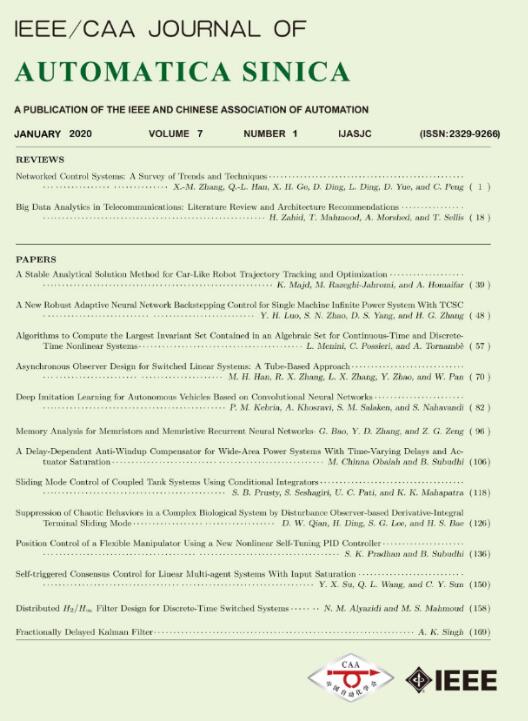 Volume 7
Issue 1
Volume 7
Issue 1
IEEE/CAA Journal of Automatica Sinica
| Citation: | Teng Wang, Leping Bu, Zhikai Yang, Peng Yuan and Jineng Ouyang, "A New Fire Detection Method Using a Multi-Expert System Based on Color Dispersion, Similarity and Centroid Motion in Indoor Environment," IEEE/CAA J. Autom. Sinica, vol. 7, no. 1, pp. 263-275, Jan. 2020. doi: 10.1109/JAS.2019.1911546 |

| [1] |
R. Bogue, " Sensors for fire detection,” Sens. Rev., vol. 33, no. 2, pp. 99–103, Mar. 2013. doi: 10.1108/02602281311299635
|
| [2] |
R. W. Fitzgerald, B. J. Meacham. Fire Detection. John Wiley & Sons, Ltd., 2017.
|
| [3] |
T. H. Chen, P. H. Wu, and Y. C. Chiou, " An early fire-detection method based on image processing,” in Proc. Int. Conf. Image Processing, Singapore, Singapore, 2004, pp. 1707–1710.
|
| [4] |
T. Çelik and H. Demirel, " Fire detection in video sequences using a generic color model,” Fire Saf. J., vol. 44, no. 22, pp. 147–158, Feb. 2009.
|
| [5] |
T. Wang, L. P. Bu, Q. F. Zhou, and Z. L. Yang, " A new fire recognition model based on the dispersion of color component,” in Proc. IEEE Int. Conf. Progress in Informatics and Computing, Nanjing, China, 2015, pp. 138–141.
|
| [6] |
R. Di Lascio, A. Greco, A. Saggese, and M. Vento, " Improving fire detection reliability by a combination of videoanalytics,” in Proc. 11th Int. Conf. Image Analysis and Recognition, Vilamoura, Portugal, 2014, pp. 477–484.
|
| [7] |
C. W. Chiu, T. Lu, H. T. Chao, and C. M. Shu, " Performance assessment of video-based fire detection system in tunnel environment,” Tunn. Undergr. Space Technol., vol. 40, pp. 16–21, Feb. 2014. doi: 10.1016/j.tust.2013.09.001
|
| [8] |
J. H. Zhang, J. Zhuang, H. F. Du, and S. A. Wang, " Flame detection algorithm based on video multi-feature fusion,” J. Xi’an Jiaotong Univ., vol. 40, no. 7, pp. 811–814, Jul. 2006.
|
| [9] |
S. D. Wang, Y. P. He, J. J. Zou, B. B. Duan, and J. Wang, " A flame detection synthesis algorithm,” Fire Technol., vol. 50, no. 4, pp. 959–975, Jul. 2014. doi: 10.1007/s10694-012-0321-6
|
| [10] |
A. Rafiee, R. Dianat, M. Jamshidi, R. Tavakoli, and S. Abbaspour, " Fire and smoke detection using wavelet analysis and disorder characteristics,” in Proc. 3rd Int. Conf. Computer Research and Development, Shanghai, China, 2011, pp. 262–265.
|
| [11] |
Y. H. Habiboğlu, O. Günay, and A. E. Çetin, " Covariance matrix-based fire and flame detection method in video,” Mach. Vis. Appl., vol. 23, no. 6, pp. 1103–1113, Nov. 2012. doi: 10.1007/s00138-011-0369-1
|
| [12] |
P. Foggia, A. Saggese, and M. Vento, " Real-time fire detection for video-surveillance applications using a combination of experts based on color, shape, and motion,” IEEE Trans. Circuits Syst. Video Technol., vol. 25, no. 9, pp. 1545–1556, Sep. 2015. doi: 10.1109/TCSVT.2015.2392531
|
| [13] |
B. C. Ko, J. H. Jung, and J. Y. Nam, " Fire detection and 3D surface reconstruction based on stereoscopic pictures and probabilistic fuzzy logic,” Fire Saf. J., vol. 68, pp. 61–70, Aug. 2014. doi: 10.1016/j.firesaf.2014.05.015
|
| [14] |
S. Verstockt, S. van Hoecke, P. De Potter, P. Lambert, C. Hollemeersch, B. Sette, B. Merci, and R. van de Walle, " Multi-modal time-of-flight based fire detection,” Multimed. Tools Appl., vol. 69, no. 2, pp. 313–338, Mar. 2014. doi: 10.1007/s11042-012-0991-6
|
| [15] |
P. Gomes, P. Santana, and J. Barata, " A vision-based approach to fire detection,” Int. J. Adv. Robot. Syst., vol. 11, no. 9, pp. 149, Sep. 2014. doi: 10.5772/58821
|
| [16] |
T. Li, " Research on methods of multiple objects tracking in intelligent visual surveillance,” Ph.D. dissertation, USTC, Hefei, China, 2013.
|
| [17] |
A. Stadler, T. Windisch, and K. Diepold, " Comparison of intensity flickering features for video based flame detection algorithms,” Fire Saf. J., vol. 66, pp. 1–7, May 2014. doi: 10.1016/j.firesaf.2014.03.001
|
| [18] |
B. Lou, Y. Xu, and Z. G. Lin, " Image characteristic analysis of moving fire diffusion flame in circular motion,” J. Combust. Sci. Technol., vol. 19, no. 1, pp. 60–66, Feb. 2013.
|
| [19] |
L. Shi, F. F. Shi, T. Wang, L. P. Bu, and X. G. Hou, " A new fire detection method based on the centroid variety of consecutive frames,” in Proc. 2nd Int. Conf. Image, Vision and Computing, Chengdu, China, 2017.
|
| [20] |
S. Tulyakov, S. Jaeger, V. Govindaraju, and D. Doermann, " Review of classifier combination methods,” in Machine Learning in Document Analysis and Recognition, S. Marinai and H. Fujisawa, Eds. Berlin, Heidelberg, Germany: Springer, 2008, pp. 361–386.
|
| [21] |
J. Kittler, " Combining classifiers: a theoretical framework,” Pattern Anal. Appl., vol. 1, no. 1, pp. 18–27, Mar. 1998. doi: 10.1007/BF01238023
|
| [22] |
B. U. Töreyin, Y. Dedeoglu, U. Güdükbay, and A. E. Çetin, " Computer vision based method for real-time fire and flame detection,” Pattern Recognit. Lett., vol. 27, no. 1, pp. 49–58, Jan. 2006. doi: 10.1016/j.patrec.2005.06.015
|
| [23] |
A. E. Cetin, " Computer vision based fire detection software,” 2014. [Online]. Available: http://signal.ee.bilkent.edu.tr/VisiFire/
|
| [24] |
L. Lam and C. Y. Suen, " Optimal combinations of pattern classifiers,” Pattern Recognit. Lett., vol. 16, no. 9, pp. 945–954, Sep. 1995. doi: 10.1016/0167-8655(95)00050-Q
|